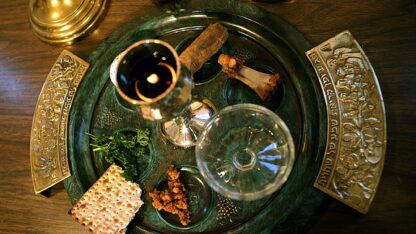It’s the Muslim holy month of Ramadan and the Royal Hyatt convention center, which usually hosts wedding receptions, has been turned into a kitchen for Pista House, one of this southern Indian city’s top restaurants. A huge hall is full of dozens of workers dressed in yellow shirts and hairnets, busy crushing cardamom pods, peeling onions and de-stalking little piles of fresh green chili peppers.
But there’s only one dish on the menu.
It’s haleem — a thick meat and lentil stew, cooked for hours, pounded into a paste and flavored with rose petals, cinnamon and cardamom, among other spices.
Around the world, the Ramadan dawn-to-dusk fast is usually followed by a feast. And in Hyderabad, that feast is dominated by haleem.
Pista House alone makes thousands of pounds of it each day during Ramadan, says Mohammed Mohddis Ali, whose family owns the chain of more than two dozen restaurants. With goat meat, coarsely ground wheat and lentils, haleem makes for the perfect meal between fasts, says Pista House’s media coordinator, Fayaz Farooqui.
“It is like an energy food. I bet I could fast for two days straight if I eat one bowl of haleem,” he says with a laugh.
With its mushy, cardboard-colored appearance, haleem may not look as tempting as biryani, Hyderabad’s other famous delicacy. But what it lacks in looks, it more than makes up for in taste — as evidenced by the crowds that throng haleem stalls every Ramadan.
“It is tasty, yummy. You can’t compare this dish to anything else,” says Sai Mudhiraj, who has stopped on his way home from work to savor haleem at a Pista House outlet.
“It hits your palate,” says historian Sajjad Shahid, a native of Hyderabad. “It is quite a satisfying meal.”
The dish is popular among non-Muslim Indians too, even as Hindu nationalists who consider meat impure continue to politicize it and try to dictate the foods Indians consume.
Making haleem is physically demanding
The cooking starts in the wee hours of the morning, Ali says. In an open space behind the Royal Hyatt hall, hunks of goat meat and green chilies have been boiling for almost eight hours. With about 20 giant wood furnaces blazing, the temperature in this part of the kitchen can go over 150 degrees Fahrenheit, the workers say, as they come to check the meat every now and then.
“[Haleem] is very easy to eat but it’s very hard to cook,” says Ali, as his eyes start to water from the smoke. The wood furnace is a requirement for Hyderabadi haleem.
After the meat becomes tender, cooks add the other ingredients — wheat, three varieties of lentils, ginger-garlic paste and a heap of spices including cinnamon, rose petals, black peppercorn, cumin, cardamom and caraway seeds.
Then comes the most physically challenging part of the recipe. Teams of two cooks, armed with long sticks with wooden slabs at the ends, tackle each pot and pound the steaming mixture, sending flecks of meat flying. The pounding gives the haleem its smooth, soft texture, says Ali.
After about half an hour of smashing, the contents of the pots come together to form a pale beige paste which workers scoop out into buckets and dump into pre-greased containers that are dispatched to more than two dozen Pista House restaurants and pop-up stalls across the city. Before it is served to hungry Hyderabadis, each dish of haleem is topped off with a generous serving of ghee, a sprinkling of coriander, some crispy fried onions and a piece of lemon on the side.
Haleem’s origins are in the Middle East
Haleem came to India from the Arab world. Starting in the 17th century, the pre-independence Muslim rulers of Hyderabad, called nizams, hired men from Yemen as mercenaries, says Shahid.
“The personal bodyguards of the ruler used to be mostly Arabs,” he says. These men serving in the Deccan, the south-central region of India where Hyderabad is located, would prepare harees, a meat and lentil dish from their homeland. Modern-day haleem is a version of harees.
“When on the move, they can’t have a four-course or six-course meal, it has to be something practical, something which is made at one go, served at one go and eaten at one go,” says Shahid.
The humble gruel even comes up in literature from the time. One 17th century Dakhni-language poem extolling the might of the army of a Deccan ruler describes the degh, the vessel in which harees was cooked, “as large as the ears of elephants,” says Shahid.
Harees, still sold in some parts of Hyderabad, is milder than haleem and also comes in a sweet variant.
Shahid, 62, says his family has been making haleem for Ramadan for as long as he can remember, but that it only recently became popular in the commercial sense.
“The craze that you see now, that happened sometimes in the 1980s or ’90s,” he says, when Iranian cafes in Hyderabad started selling it.
Locals tweaked it by adding Indian elements such as crushed ginger and garlic. In the early 2000s, Pista House’s version, which uses a plethora of masalas and ghee, or clarified butter, instead of oil started becoming popular. Thus a distinct dish was born.
In 2010, the government of India awarded it with a geographical indication status, recognizing it as authentic Hyderabadi haleem.
“To qualify as authentic, it must be made with goat meat; the ratio of meat to wheat must be 10:4; the ghee must be laboratory certified as totally pure and the dish must be cooked in a copper pot over firewood for twelve hours,” writes culinary author Colleen Taylor Sen in her book “Feasts and Fasts: A History of Food in India.”
Today haleem is available in several Indian cities, as well as in Pakistan and Bangladesh — but Hyderabadis claim their version is superior.
For the most part, you can distinguish Hyderabadi haleem from the others, says Shahid. “The number of different types of grains that are put in, the amount of meat that goes in. I think all that makes a difference,” he says. The Hyderabadi version is also more of a paste — other cities’ haleem is chunkier.
Haleem’s popularity cuts across faiths
Today, Hyderabadi haleem enjoys a cult following — especially during Ramadan.
“Once you have haleem in Hyderabad, you won’t have it anywhere else,” boasts Kamal Kant, as he shares a bowl with his wife Anita, who is tasting — and enjoying — it for the first time.
Shahid, the historian, isn’t too fond of the famous haleems, though, and thinks restaurants have gone overboard with the spices. He prefers to have his haleem at a small eatery called Cafe Diamond, which sells a relatively mild version of the dish.
Vaishak Damodar, a diner relishing a classic goat meat haleem, says he eats haleem almost every day during Ramadan. “I roam around the city and I try haleem at all different spots,” he says. He’s even tried unorthodox varieties, like the emu haleem that one restaurant came up with a few years ago, and fish haleem — which tasted odd, he says.
At the roadside stall where Damodar is eating, most customers, including him, are Hindu.
Haleem’s popularity cuts across faiths. But in recent years, meat has become politicized in India, as religious polarization rises. Some Hindus don’t eat meat. Earlier this month, the mayor of South Delhi, with the ruling Hindu nationalist Bharatiya Janata Party, called for meat shops to be shut for nine days during the Hindu festival of Navratri when some faithful don’t eat meat or eggs. Violence also broke out on a college campus in the capital over meat being served in its hostels during Navratri.
Damodar says that’s all politics. It will not change his love for haleem.
“For me, haleem is a feel-good factor. You just come, you eat, go,” he says.
Food, he says, brings a lot of people together.
Copyright 2022 NPR. To see more, visit https://www.npr.org.
9(MDAxODM0MDY4MDEyMTY4NDA3MzI3YjkzMw004))

9(MDAxODM0MDY4MDEyMTY4NDA3MzI3YjkzMw004))









